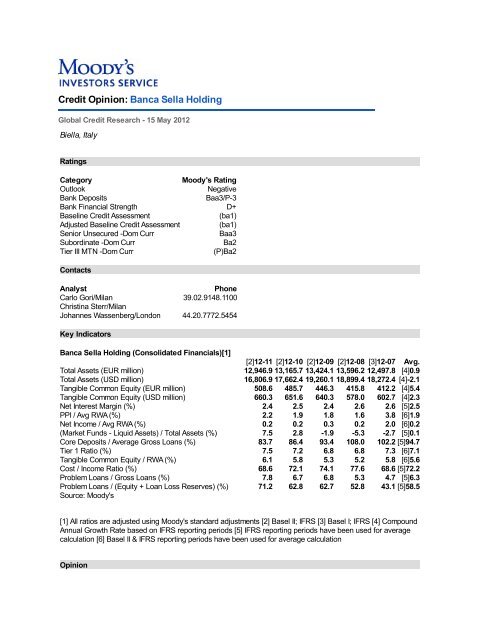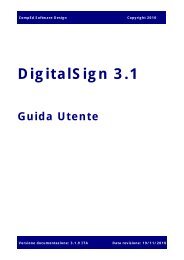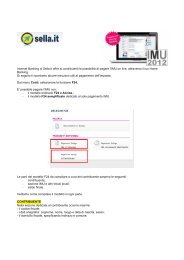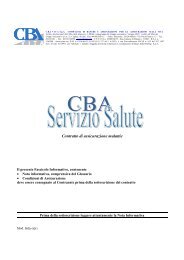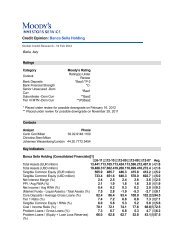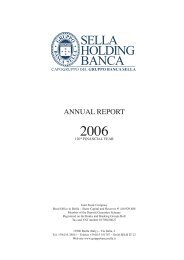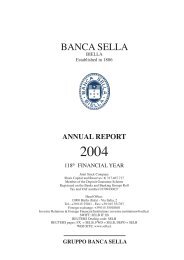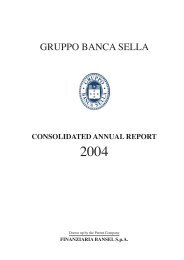Credit Opinion: Banca Sella Holding - Gruppo Banca Sella
Credit Opinion: Banca Sella Holding - Gruppo Banca Sella
Credit Opinion: Banca Sella Holding - Gruppo Banca Sella
Create successful ePaper yourself
Turn your PDF publications into a flip-book with our unique Google optimized e-Paper software.
<strong>Credit</strong> <strong>Opinion</strong>: <strong>Banca</strong> <strong>Sella</strong> <strong>Holding</strong><br />
Global <strong>Credit</strong> Research - 15 May 2012<br />
Biella, Italy<br />
Ratings<br />
Category Moody's Rating<br />
Outlook Negative<br />
Bank Deposits Baa3/P-3<br />
Bank Financial Strength D+<br />
Baseline <strong>Credit</strong> Assessment (ba1)<br />
Adjusted Baseline <strong>Credit</strong> Assessment (ba1)<br />
Senior Unsecured -Dom Curr Baa3<br />
Subordinate -Dom Curr Ba2<br />
Tier III MTN -Dom Curr (P)Ba2<br />
Contacts<br />
Analyst Phone<br />
Carlo Gori/Milan 39.02.9148.1100<br />
Christina Sterr/Milan<br />
Johannes Wassenberg/London 44.20.7772.5454<br />
Key Indicators<br />
<strong>Banca</strong> <strong>Sella</strong> <strong>Holding</strong> (Consolidated Financials)[1]<br />
[2]12-11 [2]12-10 [2]12-09 [2]12-08 [3]12-07 Avg.<br />
Total Assets (EUR million) 12,946.9 13,165.7 13,424.1 13,596.2 12,497.8 [4]0.9<br />
Total Assets (USD million) 16,806.9 17,662.4 19,260.1 18,899.4 18,272.4 [4]-2.1<br />
Tangible Common Equity (EUR million) 508.6 485.7 446.3 415.8 412.2 [4]5.4<br />
Tangible Common Equity (USD million) 660.3 651.6 640.3 578.0 602.7 [4]2.3<br />
Net Interest Margin (%) 2.4 2.5 2.4 2.6 2.6 [5]2.5<br />
PPI / Avg RWA (%) 2.2 1.9 1.8 1.6 3.8 [6]1.9<br />
Net Income / Avg RWA (%) 0.2 0.2 0.3 0.2 2.0 [6]0.2<br />
(Market Funds - Liquid Assets) / Total Assets (%) 7.5 2.8 -1.9 -5.3 -2.7 [5]0.1<br />
Core Deposits / Average Gross Loans (%) 83.7 86.4 93.4 108.0 102.2 [5]94.7<br />
Tier 1 Ratio (%) 7.5 7.2 6.8 6.8 7.3 [6]7.1<br />
Tangible Common Equity / RWA (%) 6.1 5.8 5.3 5.2 5.8 [6]5.6<br />
Cost / Income Ratio (%) 68.6 72.1 74.1 77.6 68.6 [5]72.2<br />
Problem Loans / Gross Loans (%) 7.8 6.7 6.8 5.3 4.7 [5]6.3<br />
Problem Loans / (Equity + Loan Loss Reserves) (%)<br />
Source: Moody's<br />
71.2 62.8 62.7 52.8 43.1 [5]58.5<br />
[1] All ratios are adjusted using Moody's standard adjustments [2] Basel II; IFRS [3] Basel I; IFRS [4] Compound<br />
Annual Growth Rate based on IFRS reporting periods [5] IFRS reporting periods have been used for average<br />
calculation [6] Basel II & IFRS reporting periods have been used for average calculation<br />
<strong>Opinion</strong>
RECENT CREDIT DEVELOPMENTS<br />
On 14 May 2012 <strong>Banca</strong> <strong>Sella</strong>'s (<strong>Sella</strong>) standalone bank financial strength rating (BFSR) were downgraded to D+<br />
(mapping to a standalone credit assessment of ba1) from C-/baa2 and the bank's long- and short-term deposit<br />
ratings to Baa3/Prime-3 from Baa1/Prime-2. The outlook is negative.<br />
The standalone BFSR's downgrade captures <strong>Sella</strong>'s weak internal capital generation, low capital and modest asset<br />
quality, together exposing <strong>Sella</strong>'s vulnerability under our stress scenario.<br />
However, we note the bank's above-average retail funding and revenue diversification. <strong>Sella</strong>'s funding profile shows<br />
lower-than peers reliance on wholesale market funds (the adjusted liquidity ratio stands at negative 1.1%), with a<br />
low reliance on foreign investors. Due to restricted market access, <strong>Sella</strong>'s reliance on ECB funding has however<br />
increased whereas our liquidity-gap analysis over a 12 month horizon suggests a lower than peers dependence on<br />
ECB funding. Profitability, although modest, has deteriorated less than Italian peers.<br />
In combination, these factors have largely contributed to the downgrade of <strong>Sella</strong>'s standalone BFSR.<br />
<strong>Sella</strong>'s long term global local currency (GLC) deposit rating is Baa3, based on our expectation of a moderate<br />
probability of systemic support.<br />
SUMMARY RATING RATIONALE<br />
<strong>Sella</strong>'s D+ standalone bank financial strength rating (BFSR), mapped to a standalone credit assessment of ba1,<br />
reflects the bank's modest profitability, asset quality, capital and the impact of restricted and costly access to market<br />
funding, mitigated by above average retail funding and revenue diversification.<br />
<strong>Sella</strong>'s long term global local currency (GLC) deposit rating is Baa3, based on our expectation of a moderate<br />
probability of systemic support.<br />
Rating Drivers<br />
- Low capital adequacy relative to the deteriorating asset quality<br />
- Modest efficiency and profitability<br />
- Restricted and costly access to market funding, mitigated by retail funding above the Italian average<br />
- Corporate governance constrained by the family ownership<br />
- Above average revenue diversification<br />
Rating Outlook<br />
The outlook is negative reflecting the challenging operating environment and uncertainty regarding future market<br />
access.<br />
What Could Change the Rating - Up<br />
Although we do not see any upside pressure on the rating, we would consider an upgrade following a substantial<br />
improvement in financial profile with (i) core Tier 1 above 8%; (ii) cost-to-income ratio below 65%; and (iii) problem<br />
loans below 5% of loans, on a sustainable basis.<br />
What Could Change the Rating - Down<br />
Negative pressure on the rating would develop if <strong>Sella</strong>'s financial condition failed to improve, including (i) core Tier 1<br />
below 8%; or (ii) problem loans above the Italian loan average or (iii) continued restricted market access.<br />
Recent Results<br />
In 2011 the bank reported net income of EUR 16 million. Tier 1 was 7.5%.<br />
DETAILED RATING CONSIDERATIONS
Pressure on profitability<br />
<strong>Sella</strong>'s consolidated revenue composition remains high quality. In line with the bank's strategy of reinforcing its<br />
presence in the asset management and payment systems businesses, <strong>Sella</strong> has a relatively high percentage of<br />
more stable non-interest income (51% of operating revenues), largely from asset management and payment<br />
systems, which appear sustainable.<br />
Pre-provision income and net income were modest relative to average risk-weighted assets in 2011 (2.2% and 0.2%<br />
annualised respectively). This was largely attributable to the bank's weak efficiency and high loan loss provisions of<br />
127bp. To address <strong>Sella</strong>'s weak efficiency, management has been restructuring over the past few years reducing the<br />
number of its subsidiaries, merging and liquidating subsidiaries and by differing the subdivision of activities among<br />
its subsidiaries. Some activities have been outsourced to India and Romania in order to improve the weak efficiency<br />
metrics and reduce administrative costs.<br />
We recognise that progress has been made, although, we believe that <strong>Sella</strong>'s medium size implies limited economies<br />
of scale. In our opinion, one of the bank's greatest challenges will be to balance its requirement for continuous<br />
investments (in growth, controls, compliance and IT) with the need to improve its cost structure. In 2011 the cost-toincome<br />
ratio was a high 69%, given the need to continue to invest and lower revenues.<br />
Asset-side vulnerability<br />
We view <strong>Sella</strong>'s capital level as low in view of the high level of problem loans. Because of its ownership structure,<br />
<strong>Sella</strong> does not benefit from the potentially wider access to listed companies' capital. Growth is generally limited to<br />
internal capital generation - which is also low - although supported by consistently prudent dividend payouts at 10%<br />
(zero this year).<br />
The Tier 1 ratio stood at 7.5% in 2011, which is sufficient to withstand expected losses, although not in our stressed<br />
scenario. In this respect, we understand that management is targeting significantly higher levels over the medium<br />
term, mainly through non-core asset disposals. Capital is a key driver for the bank's rating.<br />
Despite significant lending growth in the past, consolidated lending still represented a relatively low 70% of total<br />
assets in 2011, which is in line with the bank's strategy to focus on non-asset intensive businesses such as asset<br />
management. However gross problem loans, represented a high 7.8% of loans and 71% of equity and loan loss<br />
reserves in 2011. Gross problem loans include non-performing loans (sofferenze), watchlist (incagli), including only<br />
an estimate of those 90+ days overdue, restructured (ristrutturati) and past due loans (scaduti). There is modest and<br />
reducing concentration of non-performing loans to the local textile industry, which has been experiencing difficulties<br />
for some time. Strengthening risk management practices did not prevent an increase of problem loans in 2011.<br />
Challenges caused by more expensive funding access<br />
<strong>Sella</strong> enjoys a large and above average retail deposit base, with deposits constituting approximately three quarters<br />
of the funding base. The average liquidity ratio in 2011 remained one of the best in Italy, highlighting liquid assets<br />
structurally above wholesale funds. An internal policy caps the consolidated loan-to-deposit ratio. Unlike other<br />
banks, new branches do not normally develop loans before deposits. We consider ample access to retail funding as<br />
a key competitive advantage under the current difficult market conditions. Nevertheless, there is a risk that restricted<br />
and costly market access will continue for an extended period. As a result, uncertainty regarding when the bank will<br />
again be able to fund itself regularly -- and on an economic basis -- is a key credit risk and an important rating driver.<br />
Corporate governance constrains the bank's risk positioning<br />
The full ownership by the family, which designates all board members, constrains corporate governance and,<br />
potentially, risk management independence and controls compared to a listed bank. This, in turn, constrains the<br />
bank's overall risk positioning, although to improve corporate governance, several measures aimed at<br />
counterbalancing the <strong>Sella</strong> family have been implemented. While we do not have current concerns, potentially a<br />
weaker corporate governance structure in a challenging operating environment can lead to heightened risks, as<br />
evidenced by recent extraordinary administrations by the regulator. This could give rise to greater transition risk for<br />
the ratings.<br />
Diversified franchise<br />
<strong>Sella</strong> has market shares of approximately 5.3% and 3.6% for deposits and loans respectively in the Piedmont region
as of December 2011. <strong>Sella</strong> is a commercial bank operating with households and SMEs and specialises in business<br />
areas with high expected growth rates and relatively high returns, such as payment systems (where it enjoyed a<br />
market share of 7.2% on the transactions with credit cards on POS installed by the bank (acquiring) and of 2.2% on<br />
transactions related to credit cards issued by the bank (issuing)), private banking and its Internet banking operation,<br />
which ranks among the leaders in Italy.<br />
The bank is wholly owned by the <strong>Sella</strong> family, which designates all board members. To improve corporate<br />
governance, several measures aimed at counterbalancing the <strong>Sella</strong> family have been implemented. Management's<br />
current strategy involves prudent organic growth to absorb increasing compliance costs.<br />
Challenging operating environment<br />
The operating environment in Italy has become increasingly difficult for banks in recent months. This includes (i) the<br />
effects of the country re-entering recession following the severe recession in 2009; (ii) the expected impact of the<br />
government's austerity measures (taken to protect its own balance sheet); and (iii) the restricted and costly marketfunding<br />
access.<br />
Global Local Currency Deposit Rating (Joint Default Analysis)<br />
We assign Baa3 deposit and debt ratings to <strong>Sella</strong>. The ratings incorporate <strong>Sella</strong>'s standalone credit assessment of<br />
ba1 and a moderate probability of systemic support, resulting in one-notch uplift of the deposit rating from the<br />
standalone credit assessment.<br />
Bank Financial Strength Rating<br />
Bank Financial Strength Ratings<br />
Moody's Bank Financial Strength Ratings (BFSRs) represent Moody's opinion of a bank's intrinsic safety and<br />
soundness and, as such, exclude certain external credit risks and credit support elements that are addressed by<br />
Moody's Bank Deposit Ratings. Bank Financial Strength Ratings do not take into account the probability that the<br />
bank will receive such external support, nor do they address risks arising from sovereign actions that may interfere<br />
with a bank's ability to honor its domestic or foreign currency obligations. Factors considered in the assignment of<br />
Bank Financial Strength Ratings include bank-specific elements such as financial fundamentals, franchise value,<br />
and business and asset diversification. Although Bank Financial Strength Ratings exclude the external factors<br />
specified above, they do take into account other risk factors in the bank's operating environment, including the<br />
strength and prospective performance of the economy, as well as the structure and relative fragility of the financial<br />
system, and the quality of banking regulation and supervision.<br />
Global Local Currency Deposit Rating<br />
A deposit rating, as an opinion of relative credit risk, incorporates the Bank Financial Strength Rating as well as<br />
Moody's opinion of any external support. Specifically, Moody's Bank Deposit Ratings are opinions of a bank's ability<br />
to repay punctually its deposit obligations. As such, Moody's Bank Deposit Ratings are intended to incorporate those<br />
aspects of credit risk relevant to the prospective payment performance of rated banks with respect to deposit<br />
obligations, and includes: intrinsic financial strength, sovereign transfer risk (in the case of foreign currency deposit<br />
ratings), and both implicit and explicit external support elements. Moody's Bank Deposit Ratings do not take into<br />
account the benefit of deposit insurance schemes which make payments to depositors, but they do recognize the<br />
potential support from schemes that may provide assistance to banks directly.<br />
According to Moody's joint default analysis (JDA) methodology, the global local currency deposit rating of a bank is<br />
determined by the incorporation of external elements of support into the bank's Baseline <strong>Credit</strong> Assessment. In<br />
calculating the GLC rating for a bank, the JDA methodology also factors in the rating of the support provider, in the<br />
form of the local currency deposit ceiling for a country, Moody's assessment of the probability of systemic support for<br />
the bank in case a stress situation occurs and the degree of dependence between the issuer rating and the LCDC.<br />
Foreign Currency Deposit Rating<br />
Moody's ratings on foreign currency bank obligations derive from the bank's local currency rating for the same class<br />
of obligation. The implementation of JDA for banks can lead to a high local currency ratings for certain banks, which<br />
could also produce high foreign currency ratings. Nevertheless, it should be reminded that foreign currency deposit<br />
ratings are in all cases constrained by the country ceiling for foreign currency bank deposits. This may result in the
assignment of a different, and typically lower, rating for the foreign currency deposits relative to the bank's rating for<br />
local currency obligations.<br />
Foreign Currency Debt Rating<br />
Foreign currency debt ratings are derived from the bank's local currency debt rating. In a similar way to foreign<br />
currency deposit ratings, foreign currency debt obligations may also be constrained by the country ceiling for foreign<br />
currency bonds and notes, however, in some cases the ratings on foreign currency debt obligations may be allowed<br />
to pierce the foreign currency ceiling. A particular mix of rating factors are taken into consideration in order to assess<br />
whether a foreign currency bond rating pierces the country ceiling. They include the issuer's global local currency<br />
rating, the foreign currency government bond rating, the country ceiling for bonds and the debt's eligibility to pierce<br />
that ceiling.<br />
About Moody's Bank Financial Strength Scorecard<br />
Moody's bank financial strength model (see scorecard below) is a strategic input in the assessment of the financial<br />
strength of a bank, used as a key tool by Moody's analysts to ensure consistency of approach across banks and<br />
regions. The model output and the individual scores are discussed in rating committees and may be adjusted up or<br />
down to reflect conditions specific to each rated entity.<br />
Rating Factors<br />
<strong>Banca</strong> <strong>Sella</strong> <strong>Holding</strong><br />
Rating Factors [1] A B C D E Total Score Trend<br />
Qualitative Factors (50%) D+<br />
Factor: Franchise Value D Neutral<br />
Market Share and Sustainability x<br />
Geographical Diversification x<br />
Earnings Stability x<br />
Earnings Diversification [2]<br />
Factor: Risk Positioning D Neutral<br />
Corporate Governance [2] -- -- -- -- --<br />
- Ownership and Organizational Complexity -- -- -- -- --<br />
- Key Man Risk -- -- -- -- --<br />
- Insider and Related-Party Risks -- -- -- -- --<br />
Controls and Risk Management x<br />
- Risk Management x<br />
- Controls x<br />
Financial Reporting Transparency x<br />
- Global Comparability x<br />
- Frequency and Timeliness x<br />
- Quality of Financial Information x<br />
<strong>Credit</strong> Risk Concentration -- -- -- -- --<br />
- Borrower Concentration -- -- -- -- --<br />
- Industry Concentration -- -- -- -- --<br />
Liquidity Management x<br />
Market Risk Appetite x<br />
Factor: Operating Environment D Neutral<br />
Economic Stability x<br />
Integrity and Corruption x<br />
Legal System x<br />
Financial Factors (50%) D<br />
Factor: Profitability D Neutral
PPI / Average RWA - Basel II 1.99%<br />
Net Income / Average RWA - Basel II 0.26%<br />
Factor: Liquidity C Neutral<br />
(Mkt funds-Liquid Assets) / Total Assets 2.80%<br />
Liquidity Management x<br />
Factor: Capital Adequacy C Neutral<br />
Tier 1 Ratio - Basel II 7.19%<br />
Tangible Common Equity / RWA - Basel II 5.73%<br />
Factor: Efficiency D Neutral<br />
Cost / Income Ratio 71.57%<br />
Factor: Asset Quality E+ Neutral<br />
Problem Loans / Gross Loans 7.11%<br />
Problem Loans / (Equity + LLR) 65.56%<br />
Lowest Combined Score (15%) E+<br />
Economic Insolvency Override Neutral<br />
Aggregate Score D<br />
Assigned BFSR D+<br />
[1] - Where dashes are shown for a particular factor (or sub-factor), the score is based on non public information [2] -<br />
A blank score under Earnings diversification or Corporate Governance indicates the risk is neutral<br />
© 2012 Moody's Investors Service, Inc. and/or its licensors and affiliates (collectively,<br />
"MOODY'S"). All rights reserved.<br />
CREDIT RATINGS ISSUED BY MOODY'S INVESTORS SERVICE, INC. ("MIS") AND ITS<br />
AFFILIATES ARE MOODY'S CURRENT OPINIONS OF THE RELATIVE FUTURE CREDIT<br />
RISK OF ENTITIES, CREDIT COMMITMENTS, OR DEBT OR DEBT-LIKE SECURITIES, AND<br />
CREDIT RATINGS AND RESEARCH PUBLICATIONS PUBLISHED BY MOODY'S ("MOODY'S<br />
PUBLICATIONS") MAY INCLUDE MOODY'S CURRENT OPINIONS OF THE RELATIVE<br />
FUTURE CREDIT RISK OF ENTITIES, CREDIT COMMITMENTS, OR DEBT OR DEBT-LIKE<br />
SECURITIES. MOODY'S DEFINES CREDIT RISK AS THE RISK THAT AN ENTITY MAY NOT<br />
MEET ITS CONTRACTUAL, FINANCIAL OBLIGATIONS AS THEY COME DUE AND ANY<br />
ESTIMATED FINANCIAL LOSS IN THE EVENT OF DEFAULT. CREDIT RATINGS DO NOT<br />
ADDRESS ANY OTHER RISK, INCLUDING BUT NOT LIMITED TO: LIQUIDITY RISK,<br />
MARKET VALUE RISK, OR PRICE VOLATILITY. CREDIT RATINGS AND MOODY'S<br />
OPINIONS INCLUDED IN MOODY'S PUBLICATIONS ARE NOT STATEMENTS OF CURRENT<br />
OR HISTORICAL FACT. CREDIT RATINGS AND MOODY'S PUBLICATIONS DO NOT<br />
CONSTITUTE OR PROVIDE INVESTMENT OR FINANCIAL ADVICE, AND CREDIT RATINGS<br />
AND MOODY'S PUBLICATIONS ARE NOT AND DO NOT PROVIDE RECOMMENDATIONS TO<br />
PURCHASE, SELL, OR HOLD PARTICULAR SECURITIES. NEITHER CREDIT RATINGS NOR<br />
MOODY'S PUBLICATIONS COMMENT ON THE SUITABILITY OF AN INVESTMENT FOR ANY<br />
PARTICULAR INVESTOR. MOODY'S ISSUES ITS CREDIT RATINGS AND PUBLISHES<br />
MOODY'S PUBLICATIONS WITH THE EXPECTATION AND UNDERSTANDING THAT EACH<br />
INVESTOR WILL MAKE ITS OWN STUDY AND EVALUATION OF EACH SECURITY THAT IS<br />
UNDER CONSIDERATION FOR PURCHASE, HOLDING, OR SALE.<br />
ALL INFORMATION CONTAINED HEREIN IS PROTECTED BY LAW, INCLUDING BUT NOT<br />
LIMITED TO, COPYRIGHT LAW, AND NONE OF SUCH INFORMATION MAY BE COPIED OR
OTHERWISE REPRODUCED, REPACKAGED, FURTHER TRANSMITTED, TRANSFERRED,<br />
DISSEMINATED, REDISTRIBUTED OR RESOLD, OR STORED FOR SUBSEQUENT USE FOR<br />
ANY SUCH PURPOSE, IN WHOLE OR IN PART, IN ANY FORM OR MANNER OR BY ANY<br />
MEANS WHATSOEVER, BY ANY PERSON WITHOUT MOODY'S PRIOR WRITTEN CONSENT.<br />
All information contained herein is obtained by MOODY'S from sources believed by it to be<br />
accurate and reliable. Because of the possibility of human or mechanical error as well as other<br />
factors, however, all information contained herein is provided "AS IS" without warranty of any kind.<br />
MOODY'S adopts all necessary measures so that the information it uses in assigning a credit<br />
rating is of sufficient quality and from sources Moody's considers to be reliable, including, when<br />
appropriate, independent third-party sources. However, MOODY'S is not an auditor and cannot in<br />
every instance independently verify or validate information received in the rating process. Under<br />
no circumstances shall MOODY'S have any liability to any person or entity for (a) any loss or<br />
damage in whole or in part caused by, resulting from, or relating to, any error (negligent or<br />
otherwise) or other circumstance or contingency within or outside the control of MOODY'S or any<br />
of its directors, officers, employees or agents in connection with the procurement, collection,<br />
compilation, analysis, interpretation, communication, publication or delivery of any such<br />
information, or (b) any direct, indirect, special, consequential, compensatory or incidental<br />
damages whatsoever (including without limitation, lost profits), even if MOODY'S is advised in<br />
advance of the possibility of such damages, resulting from the use of or inability to use, any such<br />
information. The ratings, financial reporting analysis, projections, and other observations, if any,<br />
constituting part of the information contained herein are, and must be construed solely as,<br />
statements of opinion and not statements of fact or recommendations to purchase, sell or hold any<br />
securities. Each user of the information contained herein must make its own study and evaluation<br />
of each security it may consider purchasing, holding or selling. NO WARRANTY, EXPRESS OR<br />
IMPLIED, AS TO THE ACCURACY, TIMELINESS, COMPLETENESS, MERCHANTABILITY OR<br />
FITNESS FOR ANY PARTICULAR PURPOSE OF ANY SUCH RATING OR OTHER OPINION OR<br />
INFORMATION IS GIVEN OR MADE BY MOODY'S IN ANY FORM OR MANNER WHATSOEVER.<br />
MIS, a wholly-owned credit rating agency subsidiary of Moody's Corporation ("MCO"), hereby<br />
discloses that most issuers of debt securities (including corporate and municipal bonds,<br />
debentures, notes and commercial paper) and preferred stock rated by MIS have, prior to<br />
assignment of any rating, agreed to pay to MIS for appraisal and rating services rendered by it<br />
fees ranging from $1,500 to approximately $2,500,000. MCO and MIS also maintain policies and<br />
procedures to address the independence of MIS's ratings and rating processes. Information<br />
regarding certain affiliations that may exist between directors of MCO and rated entities, and<br />
between entities who hold ratings from MIS and have also publicly reported to the SEC an<br />
ownership interest in MCO of more than 5%, is posted annually at www.moodys.com under the<br />
heading "Shareholder Relations — Corporate Governance — Director and Shareholder Affiliation<br />
Policy."<br />
Any publication into Australia of this document is by MOODY'S affiliate, Moody's Investors Service<br />
Pty Limited ABN 61 003 399 657, which holds Australian Financial Services License no. 336969.<br />
This document is intended to be provided only to "wholesale clients" within the meaning of section<br />
761G of the Corporations Act 2001. By continuing to access this document from within Australia,<br />
you represent to MOODY'S that you are, or are accessing the document as a representative of, a<br />
"wholesale client" and that neither you nor the entity you represent will directly or indirectly<br />
disseminate this document or its contents to "retail clients" within the meaning of section 761G of<br />
the Corporations Act 2001.<br />
Notwithstanding the foregoing, credit ratings assigned on and after October 1, 2010 by Moody's<br />
Japan K.K. (“MJKK”) are MJKK's current opinions of the relative future credit risk of entities, credit<br />
commitments, or debt or debt-like securities. In such a case, “MIS” in the foregoing statements<br />
shall be deemed to be replaced with “MJKK”. MJKK is a wholly-owned credit rating agency
subsidiary of Moody's Group Japan G.K., which is wholly owned by Moody’s Overseas <strong>Holding</strong>s<br />
Inc., a wholly-owned subsidiary of MCO.<br />
This credit rating is an opinion as to the creditworthiness of a debt obligation of the issuer, not on<br />
the equity securities of the issuer or any form of security that is available to retail investors. It<br />
would be dangerous for retail investors to make any investment decision based on this credit<br />
rating. If in doubt you should contact your financial or other professional adviser.


